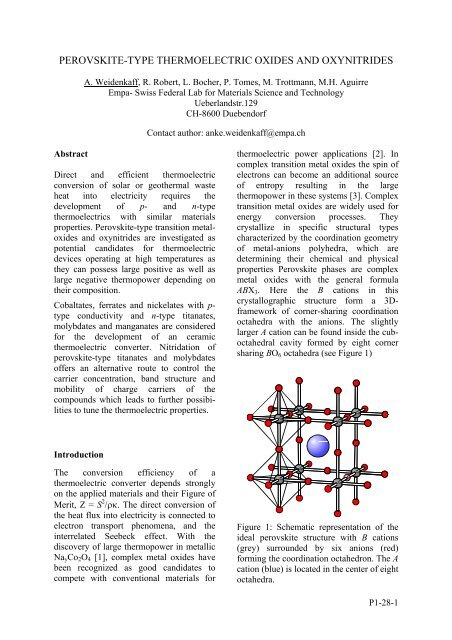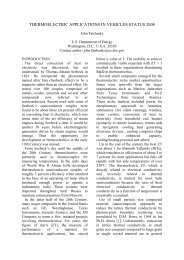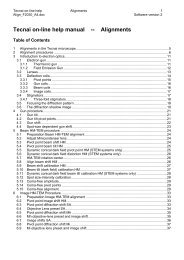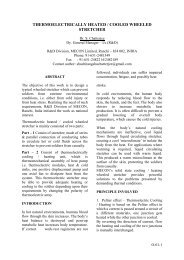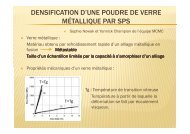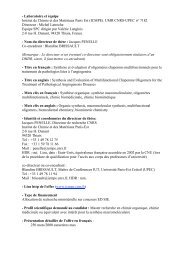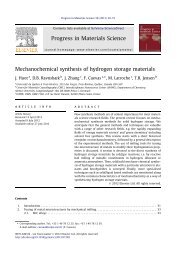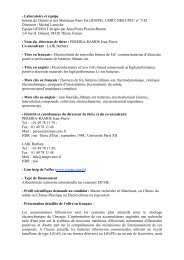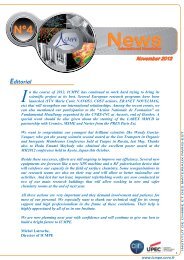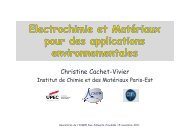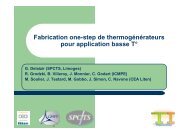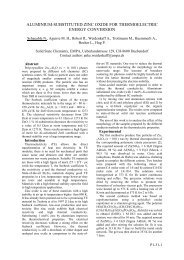Perovskite-type thermoelectric oxides and oxynitrides - ECT2008
Perovskite-type thermoelectric oxides and oxynitrides - ECT2008
Perovskite-type thermoelectric oxides and oxynitrides - ECT2008
You also want an ePaper? Increase the reach of your titles
YUMPU automatically turns print PDFs into web optimized ePapers that Google loves.
PEROVSKITE-TYPE THERMOELECTRIC OXIDES AND OXYNITRIDES<br />
A. Weidenkaff, R. Robert, L. Bocher, P. Tomes, M. Trottmann, M.H. Aguirre<br />
Empa- Swiss Federal Lab for Materials Science <strong>and</strong> Technology<br />
Ueberl<strong>and</strong>str.129<br />
CH-8600 Duebendorf<br />
Contact author: anke.weidenkaff@empa.ch<br />
Abstract<br />
Direct <strong>and</strong> efficient <strong>thermoelectric</strong><br />
conversion of solar or geothermal waste<br />
heat into electricity requires the<br />
development of p- <strong>and</strong> n-<strong>type</strong><br />
<strong>thermoelectric</strong>s with similar materials<br />
properties. <strong>Perovskite</strong>-<strong>type</strong> transition metal<strong>oxides</strong><br />
<strong>and</strong> <strong>oxynitrides</strong> are investigated as<br />
potential c<strong>and</strong>idates for <strong>thermoelectric</strong><br />
devices operating at high temperatures as<br />
they can possess large positive as well as<br />
large negative thermopower depending on<br />
their composition.<br />
Cobaltates, ferrates <strong>and</strong> nickelates with p-<br />
<strong>type</strong> conductivity <strong>and</strong> n-<strong>type</strong> titanates,<br />
molybdates <strong>and</strong> manganates are considered<br />
for the development of an ceramic<br />
<strong>thermoelectric</strong> converter. Nitridation of<br />
perovskite-<strong>type</strong> titanates <strong>and</strong> molybdates<br />
offers an alternative route to control the<br />
carrier concentration, b<strong>and</strong> structure <strong>and</strong><br />
mobility of charge carriers of the<br />
compounds which leads to further possibilities<br />
to tune the <strong>thermoelectric</strong> properties.<br />
<strong>thermoelectric</strong> power applications [2]. In<br />
complex transition metal <strong>oxides</strong> the spin of<br />
electrons can become an additional source<br />
of entropy resulting in the large<br />
thermopower in these systems [3]. Complex<br />
transition metal <strong>oxides</strong> are widely used for<br />
energy conversion processes. They<br />
crystallize in specific structural <strong>type</strong>s<br />
characterized by the coordination geometry<br />
of metal-anions polyhedra, which are<br />
determining their chemical <strong>and</strong> physical<br />
properties <strong>Perovskite</strong> phases are complex<br />
metal <strong>oxides</strong> with the general formula<br />
ABX 3 . Here the B cations in this<br />
crystallographic structure form a 3Dframework<br />
of corner-sharing coordination<br />
octahedra with the anions. The slightly<br />
larger A cation can be found inside the cuboctahedral<br />
cavity formed by eight corner<br />
sharing BO 6 octahedra (see Figure 1)<br />
Introduction<br />
The conversion efficiency of a<br />
<strong>thermoelectric</strong> converter depends strongly<br />
on the applied materials <strong>and</strong> their Figure of<br />
Merit, Z = S 2 /ρκ. The direct conversion of<br />
the heat flux into electricity is connected to<br />
electron transport phenomena, <strong>and</strong> the<br />
interrelated Seebeck effect. With the<br />
discovery of large thermopower in metallic<br />
Na y Co 2 O 4 [1], complex metal <strong>oxides</strong> have<br />
been recognized as good c<strong>and</strong>idates to<br />
compete with conventional materials for<br />
Figure 1: Schematic representation of the<br />
ideal perovskite structure with B cations<br />
(grey) surrounded by six anions (red)<br />
forming the coordination octahedron. The A<br />
cation (blue) is located in the center of eight<br />
octahedra.<br />
P1-28-1
The amount of charge carriers <strong>and</strong> thus the<br />
electrical conductivity <strong>and</strong> <strong>thermoelectric</strong><br />
properties in this system can be tuned by<br />
suitable substitution reactions.<br />
The heat transfer in solids is governed by<br />
the lattice contribution (phonon vibrations)<br />
<strong>and</strong> the electronic component<br />
corresponding to the electron motions. For<br />
<strong>oxides</strong> the phonon contribution remains the<br />
predominant component of the total thermal<br />
conductivity. Strategies to lower the lattice<br />
heat conduction, i.e. enhance the phonon<br />
scattering include the application of<br />
nanostructures [4]. The interface scattering<br />
of phonons can dominate the heat<br />
conduction in oxide nanostructures.<br />
In addition to cationic substitutions <strong>and</strong><br />
introduction of defects into the oxygen<br />
sublattice, the exchange of oxygen by other<br />
anions such as halides or nitrides can be<br />
used to influence the properties of the<br />
perovskite-<strong>type</strong> compounds significantly.<br />
Therefore an oxygen- nitrogen exchange in<br />
perovskite-<strong>type</strong> <strong>oxides</strong> was performed with<br />
an ammonolysis reaction.<br />
Experimental<br />
<strong>Perovskite</strong>-<strong>type</strong> <strong>oxides</strong> with diverse<br />
composition were produced by a chimie<br />
douce synthesis process. Powders of the<br />
Ca- <strong>and</strong> Ni-substituted substituted Lacobaltates<br />
<strong>and</strong> manganates were<br />
synthesised with diverse precursor<br />
reactions. The precursors were obtained by<br />
dissolving the required amount of La(NO 3 ) 3<br />
∗ 6 H 2 O (Merck, ≥ 97%), Mn(NO 3 ) 2 ∗ 6<br />
H 2 O (Merck, ≥ 99%), Ca(NO 3 ) 2 ∗ 6 H 2 O<br />
(Merck, ≥ 97%) Ni(NO 3 ) 2 ∗ 6 H 2 O (Merck,<br />
≥ 97%) <strong>and</strong> Co(NO 3 ) 2 ∗ 6 H 2 O (Merck, ≥<br />
97%) etc. in water <strong>and</strong> mixing them with a<br />
chelating agent, e.g. citric acid. These<br />
complexes were polymerised in a second<br />
step <strong>and</strong> dried to obtain homogeneous<br />
aerogel precursors. The ammonolysis was<br />
conducted in either thermal reactions or in a<br />
plasma enhanced chemical reaction using a<br />
microwave induced ammonia plasma<br />
reactor. The thermal ammonolysis reaction<br />
was performed at temperatures of<br />
900°C
p- <strong>and</strong> n-<strong>type</strong> legs are produced with the<br />
obtained samples <strong>and</strong> assembled to all<br />
perovskite ceramic <strong>thermoelectric</strong><br />
converters.<br />
Results<br />
Among a wide range of potential<br />
perovskite-<strong>type</strong> c<strong>and</strong>idates with positive<br />
<strong>and</strong> negative thermopower for<br />
<strong>thermoelectric</strong> applications we selected<br />
semiconducting cobaltates, titanates <strong>and</strong><br />
manganates values (see figure 2) to study<br />
possibilities for improving the figure of<br />
merit ZT = S 2 T/ρκ by enhancing the<br />
electrical conductivity <strong>and</strong> the Seebeck<br />
coefficient with appropriate cationic<br />
substitutions <strong>and</strong> by lowering the heat<br />
conductivity with decreasing the particle<br />
size [6-8].<br />
]1.62<br />
Thermopower S(µV/K)<br />
CoO3<br />
300<br />
200<br />
100<br />
0<br />
-100<br />
-200<br />
CoO3<br />
-300<br />
(La,Sr)TiO 2<br />
N<br />
Mo=3<br />
[Ca 2<br />
CoO 3<br />
][CoO 2<br />
] 1.62<br />
MnO3<br />
(La,Sr)CoO 3<br />
Figure 2: Many perovskite-<strong>type</strong> phases<br />
show a high <strong>thermoelectric</strong> activity with<br />
positive Seebeck coefficient as well as<br />
negative Seebeck coefficient.<br />
Ti)O3<br />
(La,Ca)CoO 3<br />
A series of A <strong>and</strong> B-site substituted<br />
lanthanum cobaltate, manganate <strong>and</strong><br />
molybdate compounds with various<br />
compositions <strong>and</strong> perovskite structure<br />
have been successfully synthesised by<br />
the polymeric precursor method [9]. All<br />
samples are single phase <strong>and</strong> crystallize in<br />
perovskite-<strong>type</strong> crystal structure.<br />
The thermal conductivity can be reduced by<br />
lowering the particle dimensions to the<br />
nanometer scale with a chimie douce<br />
synthesis method (see figure 3).<br />
MnO3<br />
Sr(Ru,Ti)O 3<br />
(La,Ca)TiO 3<br />
La(Co,Ti)O 3<br />
(La,Sr)MnO 3<br />
Figure 3: TEM view of lanthanum titanate<br />
particles produced by a chimie douce<br />
method.<br />
The electrical resistivity generally<br />
decreases with increasing temperature,<br />
representing a semiconducting-like<br />
behaviour (dρ/dT < 0). With the appropriate<br />
substitutions the conduction mechanism of<br />
Lanthanum cobaltates can be changed from<br />
p-<strong>type</strong> semiconductors to n-<strong>type</strong><br />
semiconductors, i.e. electron conduction<br />
mechanism to hole conduction mechanism<br />
respectively. Substitution of trivalent La<br />
cations on the A-site position with<br />
tetravalent cations (e.g. Ce 4+ ) or<br />
substitution in the B-site Co 3+ matrix with<br />
tetravalent cations (e.g. Ti 4+ ) produces<br />
mixed valence states of Co 3+ <strong>and</strong> Co 2+ . The<br />
Seebeck coefficient of the manganates <strong>and</strong><br />
nitrogen doped titanates is negative.<br />
Conclusions<br />
<strong>Perovskite</strong>-<strong>type</strong> cobaltate, manganate <strong>and</strong><br />
titanate <strong>thermoelectric</strong>s were successfully<br />
synthesised <strong>and</strong> characterised. The<br />
electrical conductivity, the Seebeck<br />
coefficient <strong>and</strong> the thermal conductivity<br />
were measured in a broad temperature<br />
range. The studied perovskite-<strong>type</strong> phases<br />
show potential for <strong>thermoelectric</strong><br />
applications, as the thermopower relies on<br />
the tuneable itinerant charge carriers. The<br />
sign <strong>and</strong> the absolute value of the Seebeck<br />
coefficient can be changed with hole or<br />
electron doping. By combining suitable p-<br />
P1-28-3
<strong>and</strong> n- typ materials perovskite-<strong>type</strong><br />
<strong>thermoelectric</strong> converters can be produced.<br />
Acknowledgements<br />
The authors thank the Swiss Federal Office of<br />
Energy for financial support.<br />
References<br />
1. Terasaki, I., Y. Sasago, <strong>and</strong> K.<br />
Uchinokura, Large <strong>thermoelectric</strong> power<br />
in NaCo2O4 single crystals. Phys.Rev. B,<br />
1997. 56: p. R12685.<br />
2. Maignan, A., et al., Large Thermopower<br />
in Metallic Misfit Cobaltites. Chemistry<br />
of Materials, 2001. 14: p. 1231-1235.<br />
3. Wang, Y., et al., Spin entropy as the<br />
likely source of enhanced thermopower in<br />
NaxCo2O4. Nature, 2003. 423(6938): p.<br />
425-428.<br />
4.Chen, G., et al., Recent developments in<br />
<strong>thermoelectric</strong> materials. International<br />
Materials Reviews, 2003. 48: p. 45-66.<br />
5. Rodriguez-Carvajal, J. FULLPROF. in<br />
Satellite Meeting on Powder diffraction of<br />
the XVth Congress of the IUCr. 1990.<br />
6. Bocher, L., et al., Thermoelectric <strong>and</strong><br />
magnetic properties of perovskite-<strong>type</strong><br />
manganate phases synthesised by<br />
ultrasonic spray combustion (USC). Solid<br />
State Sciences, 2008. 10(4): p. 496-501.<br />
7. Robert, R., et al., Thermoelectric<br />
properties of LaCo1-xNixO3<br />
polycrystalline samples <strong>and</strong> epitaxial thin<br />
films. Solid State Sciences, 2008. 10(4):<br />
p. 502-507.<br />
8. Weidenkaff, A., et al., Development of<br />
<strong>thermoelectric</strong> <strong>oxides</strong> for renewable<br />
energy conversion technologies.<br />
Renewable Energy, 2008. 33(2): p. 342-<br />
347.<br />
9. Weidenkaff, A., Preparation <strong>and</strong><br />
application of nanoscopic perovskite<br />
phases. Advanced Engineering Materials,<br />
2004. 6: p. 709-714.<br />
P1-28-4


